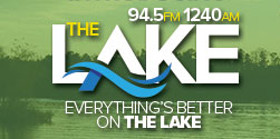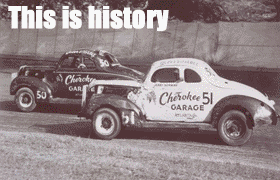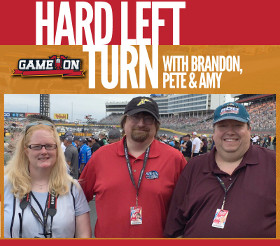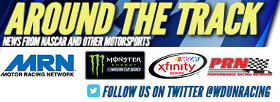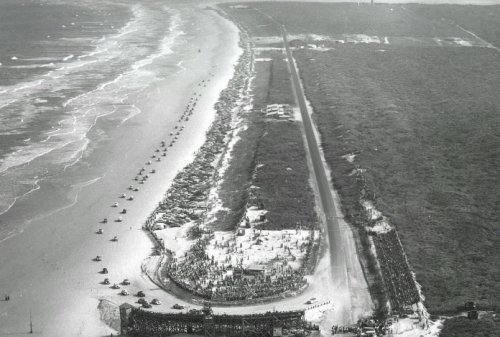
Long before the construction of the Daytona International Speedway, racers proved themselves on the old Daytona Beach course, which was made up of two miles of US A1A traveling south, and two miles of the hard packed Daytona Beach sands traveling north. This photos shows cars on the parade lap for an event traveling through the track's north turn. Photo courtesy GRHOF
You could call Daytona’s Beach & Road Course one of America’s first off-road competitions. At least part of it.
More than half of the temporary track was sand, a pair of turns and a long strip of beach linked to Route A1A’s pavement. It was unique to say the least but ultimately drew tens of thousands of post-war race fans to Central Florida before Speedweeks was shifted a few miles northwest to Daytona International Speedway in 1959.
“It was just like a dirt track,” said NASCAR Hall of Fame member Glen Wood, who won three sportsman races on the beach and finished 11th in his only NASCAR premier series start in 1957. “The turns were like a half-mile track – one bank to the other.”
On Friday, last year’s Daytona 500 champion Trevor Bayne will drive his No. 21 Wood Brothers Ford over a section of the beach course to the track’s former north turn. Following a press conference, Bayne will continue on to the speedway, where he’ll present the American Ethanol Green Flag to symbolically open 2012 Speedweeks festivities.
Racing began on a 3.2-mile course in 1936. Daytona Beach racer Sig Haugdahl promoted the first two events, which weren’t commercially successful. City officials gave promotional rights to Bill France, who wore both a promoter’s hat and a competitor’s helmet – and with the latter won the Labor Day event in 1938 and a July race the following year.
France reinstated competition following World War II. The course was lengthened to 4.1 miles, beginning at 4511 S. Atlantic Blvd. then continuing two miles down paved A1A to the Beach Street approach where the track’s south turn took the field onto the packed sand for a two-mile run back to the north turn. The races were scheduled to coincide with low tide.
The formation of NASCAR, at the nearby Streamline Hotel, led to the beach races becoming the organization’s premier event until the construction of Darlington Raceway in 1950. The 1949 race, won by NASCAR’s first champion Red Byron, was held in July. The following year’s event was moved to February where it remains today.
Additional races for convertibles, modifieds and sportsman cars were added during NASCAR’s first decade creating the Speedweeks concept upon which France expanded even further with the opening of Daytona International Speedway in 1959. A total of 10 NASCAR premier series races were run at the Beach & Road Course.
Some highlights from those early races:
·The 1952 race, won by Marshall Teague in a Hudson, was shortened two laps because of the incoming tide.
·In 1953, a whopping 136 cars started the modified/sportsman race, still NASCAR’s largest field.
But my ability to understand the complexities of the particular industry. Lastly, patients may have Tenderness in the area for a short time afterwards. In my opinion an assessment of basic neurocognitive function should be an essential part of any psychiatric evaluation. I love shopping, I love shopping at thrift stores. ·Technical infractions caused apparent winners in 1954 and 1955 – Tim Flock and Fireball Roberts – to be disqualified handing victories to Lee Petty and Flock.
·Georgia racer Charlie Scott became the first African-American driver to start a NASCAR premier series race in 1956. Scott, driving one of Carl Kiekhaefer’s famed Chrysler 300s, finished 19th in a field of 76 cars.
·Cotton Owens drove a Pontiac, sponsored by Daytona Beach auto dealer Jim Stephens, to its first NASCAR premier series win in 1957.
Flock and Teague won twice. Byron, Owens, Petty, Harold Kite, Bill Blair and Paul Goldsmith were the race’s other winners. The race maintained its local flavor throughout the years. Teague, who later lost his life testing an Indianapolis-type roadster at Daytona International Speedway, was from Daytona Beach as was master mechanic and innovator Smokey Yunick, who fielded Goldsmith’s winning Pontiac in 1958.
Teague was nicknamed “King of the Beach” based on his performances but Wood’s favorite was Curtis Turner, who won two convertible races and had a best NASCAR premier series finish of second. Turner, along with NASCAR Hall of Fame member Bud Moore, will be inducted into the Oceanside Rotary Club of Daytona Beach’s Hall of Fame on Feb. 20. NASCAR President Mike Helton will induct Moore. Both Wood and his brother Leonard also are members of the hall.
For sure, Turner’s driving style stood out on the beach portion of the course. “He was the most spectacular of anyone,” said Wood. “He’d turn it sideways (on the straightaway) but he was under control the whole time. You knew it was him when he’d come into sight crossways. Buck Baker and Joe Weatherly were fast but not as spectacular.”
Racing conditions were hit and miss – mostly miss during the race’s latter stages. The turns would get chopped up. Historic photos taken during modified and sportsman races show cars that had gone over the embankments on their sides and left where they stopped.
“I remember Ralph Moody did a complete flip, landed back on his wheels and kept on going,” said Wood, who completed eight of the nine races in which he participated and never was involved in an accident. “If you missed the turn, you’d go down the beach, turn around and come back.”
Racing in the sportsman division, the Woods replaced their car’s vacuum-powered windshield wipers with an electrical unit which caught fire. Wood pulled off the track prepared to watch his 1950 Ford go up in flames. A man appeared out of the palmetto bushes with a CO2 extinguisher and put out the fire – a figure apparently undeterred by France’s “Beware of Rattlesnakes” signs designed to keep out non-paying customers.
“I still had my helmet on so I got back in, kept going and we still won,” said Wood.
Although the Woods towed their cars to Daytona, many competitors drove to the event, taped up headlights and raced, “basically like running on the highway,” said Wood. Not everyone, however, was able to make the return trip on four wheels.
Louise Smith, according to Wood, was one who had to make the “uh-oh” telephone call when she crashed her Ford on the first lap of the 1950 race. “She called her husband to tell him she’d wrecked it,” said Wood. “I’m not sure it was even paid for.”
